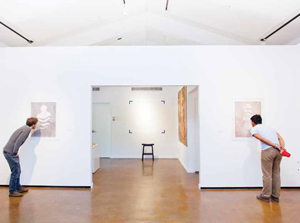Campus News
Blurring the lines
The Institute of the Arts and Sciences promises to explore unexpected convergences, provocative subjects

2012–13 Irwin scholars Ari Finkelstein and Miguel Libarnes (photo by Elena Zhukova) |
An immersive exhibit on climate change, showing wall-sized photos of Antarctica, complete with ambient sounds.
A close-up look at conceptions of human health, filled with contemporary art, African divination objects, huge photos of frozen viruses, and data from the forefront of cancer research.
A tour through the politics of water consumption and the future of America’s water supply, including satellite imagery and an interactive, multimedia look at a threatened Sierra Nevada watershed.
These are the kinds of teaching and research projects that will be showcased at UCSC’s Institute of the Arts and Sciences, an emerging endeavor that harkens to UCSC’s roots as an innovative educational experiment meant to blur the lines between disciplines to beautiful effect.
Ever since it opened its doors in 1965, UC Santa Cruz has been a place where seemingly different areas of study can “talk” to each other across the lines, much to the benefit of students and professors alike. This is a place to explore unexpected convergences between, say, visual arts and astrophysics, and computer games and climatology.
And now, the campus is about to take this kind of dialogue to a whole new level. Planning is underway for the state-of-the-art institute—part museum, part teaching/research facility, performance center, and meeting space, complete with study areas, a café, and the kind of jaw-dropping Monterey Bay views that could make it hard to focus on your lunch.
The planning committee is hashing out the size, shape, and proportions of the new institute, and an architect has not yet been selected.
But here is what we do know: the building will go up somewhere in UCSC’s arts complex; there will be thought-provoking exhibitions that are bound to get people talking; there will be dance performances, classes, and student internship and learning opportunities.
The new institute will be privately funded. It has already received a gift of $1 million from longtime community and campus philanthropists Rowland and Patricia Rebele.
“When you put an artist and a scientist in the room together, you’re going to get an interesting result, because they have different ways of looking at the world,” said Patricia Rebele (Porter ’88, art history).
Creative engagement
“This speaks to UCSC’s institutional history,” said Arts Dean David Yager. “A lot of times we talk about the classroom experience and research, but it is equally important to engage students across the university in creative and innovative ways. The institute is about the transformative
student experience.”
Besides, he said, across-the-lines thinking gets results. “Many problems can be solved by groups of people from multiple disciplines,” he said.
Yager visualizes the institute as a place for rigorous intellectual inquiry, a center for research, and an exciting destination for visitors who will be drawn to exhibits that portray complex and provocative subjects in fascinating, visual, and interactive ways.
For example, Yager is already thinking about staging an exhibit on the science and politics of water consumption, bringing together artists, climatologists, and computer scientists.
Campus catalyst
John Weber, the institute’s founding director, emphasized the creative “catalytic role” that faculty will play in germinating institute exhibitions, which will be linked to teaching and learning on campus, offering a series of starting points for student research.
Most recently the director of the Frances Young Tang Teaching Museum and Art Gallery at Skidmore College, Weber has also put in his time as the curator of education and public programs at the San Francisco Museum of Modern Art. He has a deep well of ideas to draw from, and a strong desire to make the exhibits eye popping and accessible as well as thought
provoking.
The exhibitions will be an important focal point for the institute.
“While we do not see this as a collecting institution, we can draw upon the deep and valuable collections owned by the UC Regents, and residing in other UC museums,” said Weber.
He also emphasized the institute’s system-wide role as a catalyst and collaborator bringing campuses together. And while the exhibits will have an interdisciplinary scope, there will be a strong and consistent focus on visual art.
Research showcase
The institute will also host research residencies, and include a seminar space with room for 120 people. UCSC students will benefit by attending classes there, and by using exhibits and holdings as research subjects. They can also take advantage of internship and volunteer opportunities, serve as assistants to curators for exhibit research, work as gallery monitors, and conduct peer tours or lead tours for off-campus groups.
While the institute will bring a new attraction to campus, Weber said it will also help to emphasize the cross-disciplinary learning and research that is already taking place.
“It will highlight exciting work that is going on across the campus, much of it behind closed doors,” he said. “If people are visiting campus, and you want to show them this exciting work, here is where you can take them.”